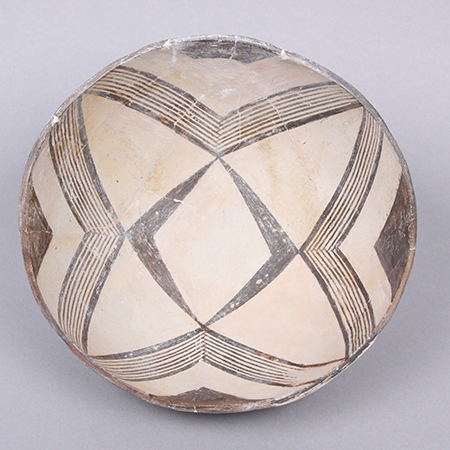

Mimbres bowl with geometric design from the Maxwell Museum CollectionsMattocks site (LA 676)MMA 89.48.8
Mimbres black-on-white pottery bowls are highly admired for their beautiful and intricate figurative and geometric designs. Their desirability to collectors has led to rampant looting and destruction of many Mimbres sites. It has also led to the production of archaeological fakes.
Maxwell Museum Curator of Archaeology Dr. Kari Schleher and Dr. Michelle Hegmon (Arizona State University) have conducted a study to explore the extent to which the inclusion of fakes in museum collections may influence research and interpretation. More specifically they ask: to what extent is research on poorly documented museum collections of Mimbres ceramics likely to yield reliable results?
In their study, which was recently presented at the 2021 Annual Meeting of the Society for American Archaeology, they compared the frequency of geometric and figurative (non-human vs. human) designs to qualitative "confidence" categories of museum collections. Through evaluating the nature and quality of collection documentation, they identified four confidence” categories for museum collections: 1. Representative (from well-documented and representatively sampled archaeological contexts), 2. Authentic (from archaeological sites with known contexts but not necessarily representative), 3. Likely authentic, and 4. Unknown.
They focused their attention specifically on representations of humans—arguing that those are the most desired by collectors and also most likely to be faked and thus can be expected to be over-represented in collections lacking reliable provenience documentation. Their analysis revealed that human figurative designs were indeed far less common in well documented archaeological collections (combined categories 1 and 2), than in poorly documented ones (combined categories 3 and 4; with a statistical significance of p <.00001).
However, when they delved deeper into the specific content of human images found in various collections categories, they did not find statistically significant variability between well and poorly documented collections. Instead, the same general kinds of depictions were found in each. They concluded that although Mimbres vessels with images of humans are over-represented in many museum collections, there Is room for cautious optimism that even poorly provenienced collections can be used in research.
Reference: Michelle Hegmon and Kari L. Schleher, 2021. Analyzing Mimbres pottery designs with confidence. Poster presented at the Annual Meetings of the Society of American Archaeology (online), April 2021.